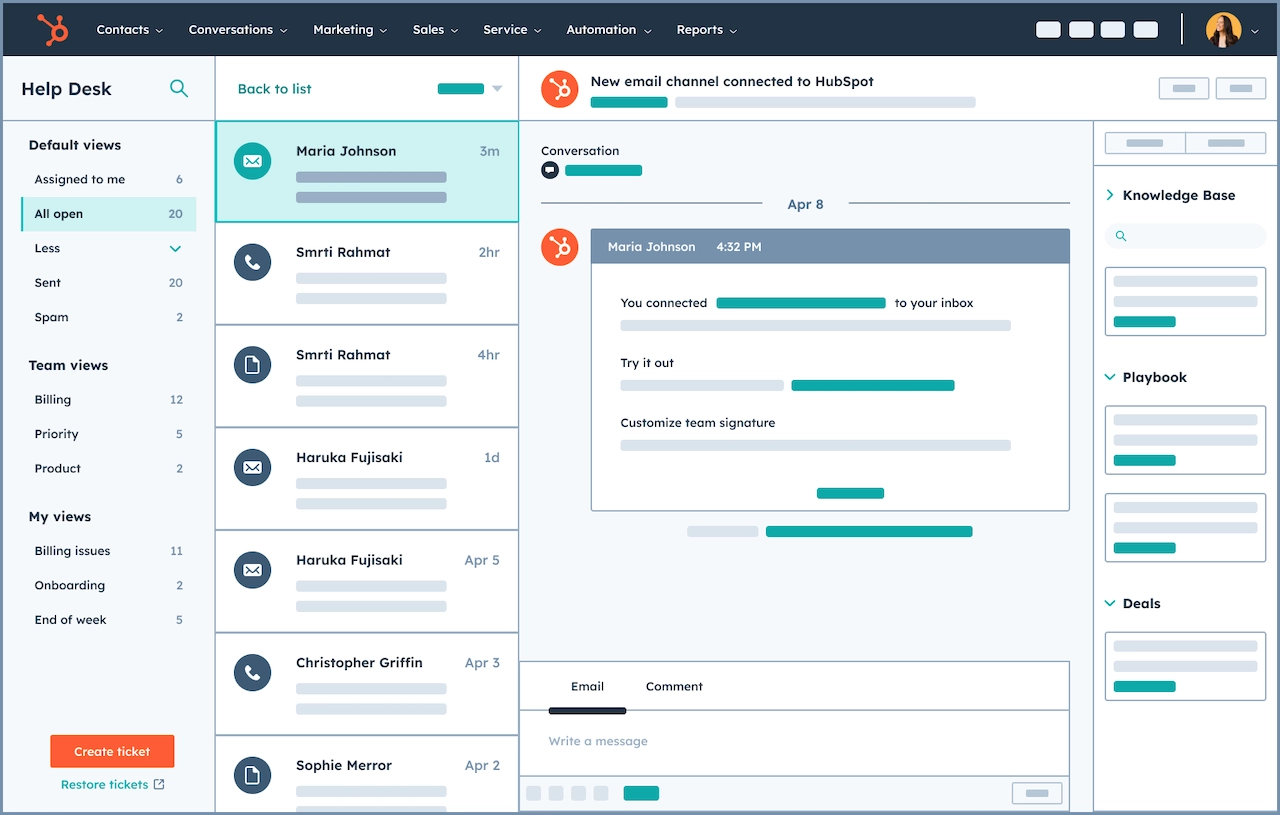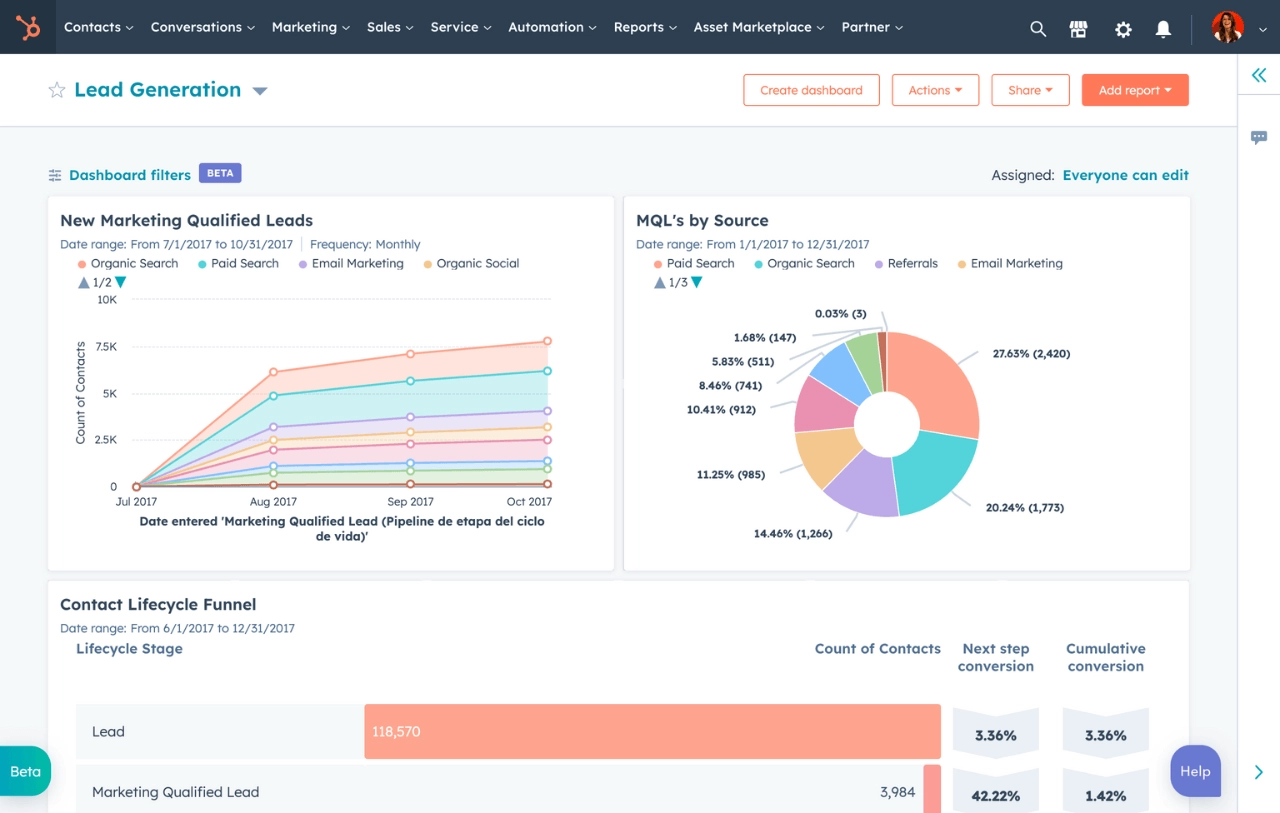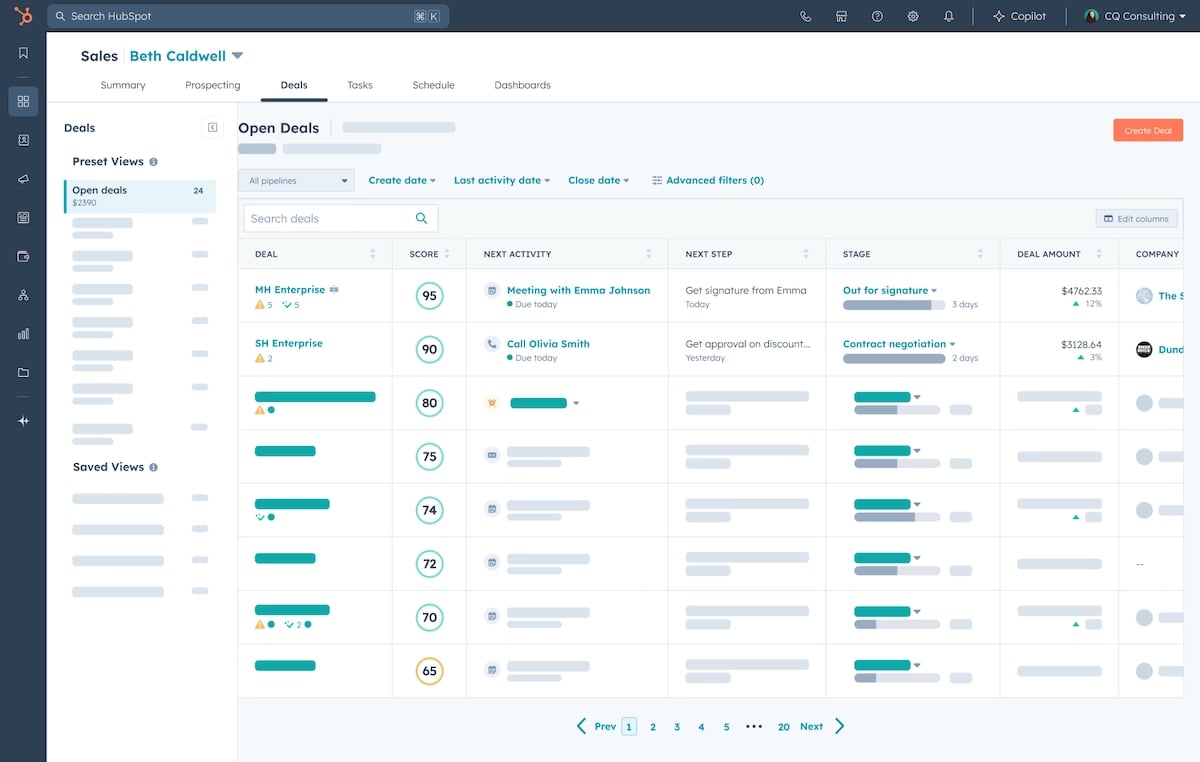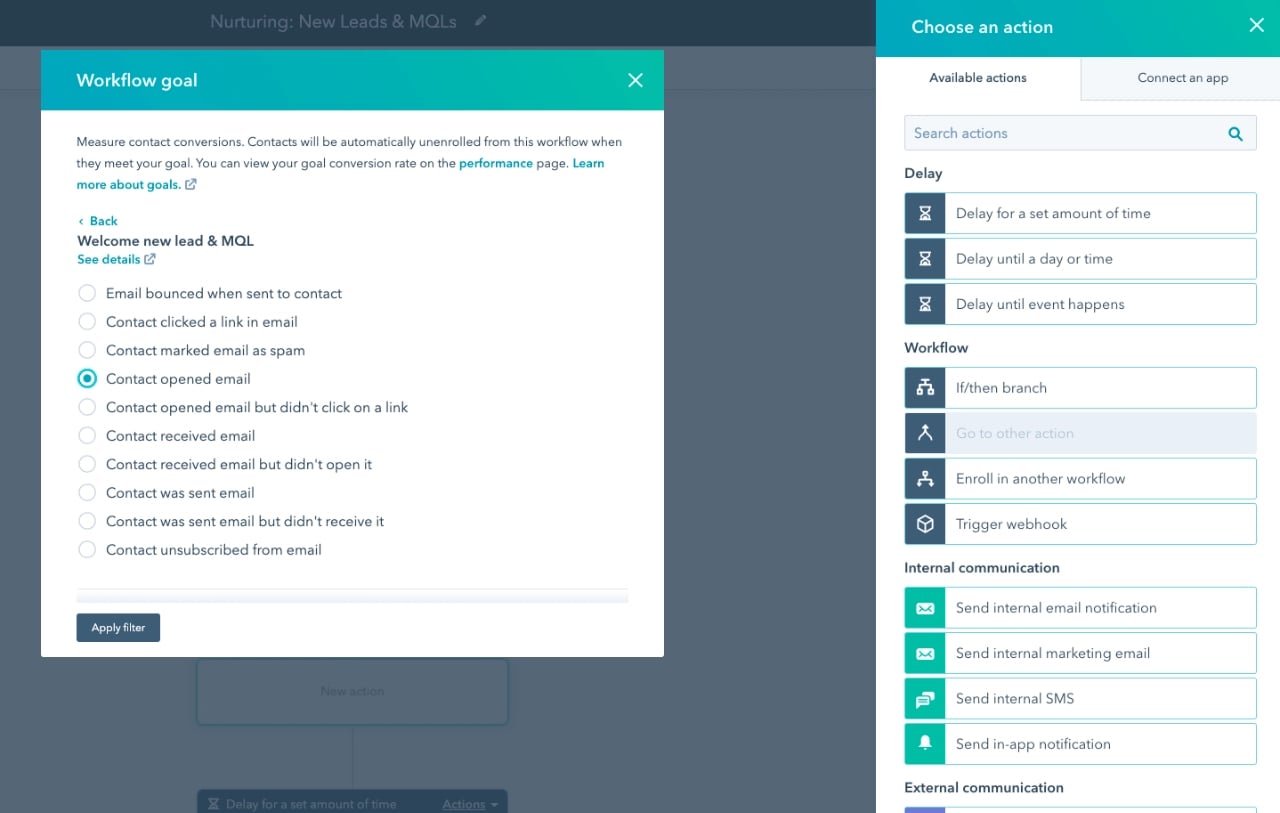
HubSpot

Partnership
Here are the various ways we partner with HubSpot.
Badges
Not sure where to start? Request a one-on-one consultation with one of our experts.
ConsultationHubSpot is a comprehensive customer platform designed to consolidate customer relationship management (CRM), marketing automation, sales enablement, customer service, and content management into one cohesive system. It enables businesses to optimise operations, enhance customer engagement, and streamline processes for greater efficiency.

CRM Hubs
HubSpot consists of several primary Hubs, each designed to address specific business functions. These Hubs can be used individually or in combination, allowing businesses to select the tools that best align with their needs and scale as they grow.
HubSpot’s Marketing Hub enables businesses to automate marketing campaigns and manage lead generation efficiently. The platform helps businesses track campaign performance with built-in analytics, allowing them to refine their strategies. It also includes social media management tools to plan and monitor posts, ensuring a unified marketing effort across all channels.
The Sales Hub streamlines the sales process by providing tools for managing pipelines and automating repetitive tasks. Sales teams can track deals in real time, allowing for better visibility into individual and team performance. The integration with HubSpot’s CRM ensures all customer data is up-to-date, facilitating personalized outreach.
The Service Hub focuses on improving customer support by offering ticket management, a self-service knowledge base, and tools for gathering customer feedback. Businesses can track support requests, resolve issues more efficiently, and gather insights to improve their service. Live chat and AI-powered bots help provide instant support to customers.
The Content Hub simplifies website creation and optimisation. With a drag-and-drop builder and responsive templates, businesses can easily create and maintain professional websites. Built-in SEO tools help improve content visibility, while personalisation features allow businesses to tailor the website experience based on user behaviour.
The Operations Hub ensures smooth data synchronisation across systems, providing a centralised view of customer information. It offers process automation features that reduce manual tasks and improve efficiency. Advanced reporting tools allow businesses to make data-driven decisions, and the Hub integrates seamlessly with third-party systems to streamline operations.
The Commerce Hub allows businesses to create and manage online stores with ease. It integrates with the other HubSpot Hubs to provide a unified platform for managing inventory, processing orders, and tracking customer data. This centralisation streamlines eCommerce operations, allowing for better customer insights and personalized shopping experiences.
Hubs can operate independently or in combination, giving businesses the flexibility to choose the tools that best meet their needs.
Scalability
HubSpot is structured to support business scalability. Organisations can begin with the free CRM and expand by integrating additional Hubs as their operational needs grow. In 2025, HubSpot advanced its AI-powered capabilities, strengthening features such as predictive lead scoring, content optimisation, and automated workflow recommendations to enhance performance and efficiency across its platform.




History
HubSpot was founded in 2006 by Brian Halligan and Dharmesh Shah at the Massachusetts Institute of Technology (MIT). Their goal was to simplify inbound marketing by enabling businesses to attract and engage customers organically through technology. This vision led to the creation of an integrated platform combining marketing tools with customer relationship management (CRM) capabilities.
Growth
Between 2007 and 2010, HubSpot experienced rapid growth, supported by multiple early funding rounds that collectively exceeded $30 million. During this period, the platform focused on core inbound marketing functions such as blogging, search engine optimisation (SEO), and lead tracking. These tools positioned HubSpot as a pioneer in inbound marketing, helping businesses shift from traditional advertising methods to more customer-centric strategies.
Expansion
Starting in 2011, HubSpot broadened its product offerings beyond marketing. The introduction of its free CRM in 2014 marked a pivotal point, allowing businesses to manage customer relationships without upfront costs. This offering quickly became a key driver of growth, extending HubSpot’s appeal across various industries.
In the years that followed, HubSpot continued to diversify its product suite. The launch of the Sales Hub and Service Hub expanded the platform’s capabilities to include sales process management and customer service operations. Additionally, the CMS Hub was introduced, allowing businesses to build, manage, and optimise their websites within the same system, further consolidating HubSpot’s position as a multi-functional platform.
IPO
HubSpot became a publicly traded company in October 2014, listing on the New York Stock Exchange under the ticker symbol HUBS. The initial public offering raised approximately $125 million, signifying a major milestone in the company’s development.
By 2021, HubSpot achieved over $1 billion in annual recurring revenue (ARR), driven by strong adoption of its suite of Hubs. The company also pursued strategic acquisitions to expand its capabilities. Notable transactions included PieSync in 2019, which strengthened data integration features; The Hustle in 2021, which expanded content marketing resources; and Clearbit in 2023, which enhanced customer data enrichment.
Capabilities
In 2024 and 2025, HubSpot introduced advanced artificial intelligence capabilities across its platform. These features included predictive lead scoring, AI-driven content generation, and intelligent workflow recommendations. The addition of these tools further reinforced HubSpot’s position as an adaptive and future-focused platform, capable of meeting the evolving demands of businesses seeking automation and data-driven insights.

Industry
HubSpot serves a wide range of industries and company sizes, positioning itself as a flexible platform adaptable to diverse operational needs. Its modular structure allows businesses to select relevant tools while maintaining centralised data management.
Adoption
HubSpot’s platform is integrated across seven primary sectors, supporting specialised business objectives within each.
Technology companies, especially in software-as-a-service (SaaS), use HubSpot for lead generation, pipeline management, and product marketing. Inbound marketing tools, automated sales tracking, and segmented outreach enable these businesses to manage customer acquisition and retention processes efficiently.
eCommerce businesses apply HubSpot to automate marketing and increase conversions. Key tools include behaviour-driven messaging, abandoned cart recovery, and customer segmentation. These features support targeted campaigns and structured post-purchase engagement workflows.
Educational institutions implement HubSpot to manage recruitment and alumni relations. Email automation, lead scoring, and application tracking support admissions activities. Alumni engagement is maintained through event promotions and segmented communication.
Healthcare providers adopt HubSpot for patient communication and workflow automation. The platform manages appointment scheduling, encrypted messaging, and regulatory-compliant marketing campaigns, aligning with healthcare privacy standards.
Nonprofits use HubSpot to streamline donor and volunteer activities. Fundraising automation, donor tracking, and multi-channel outreach tools enhance engagement efforts. Volunteer management functions support scheduling and participation tracking.
Consultancies and agencies rely on HubSpot for client acquisition and project coordination. Tools for lead qualification, proposal tracking, and automated reporting enable consistent project management and client communication.
Financial firms utilise HubSpot for onboarding, client communication, and compliance workflows. The platform supports document management, portfolio updates, and automated risk reporting, facilitating regulatory adherence and operational efficiency.
Regional
HubSpot maintains a strong and expanding global presence, with notable growth across the Asia-Pacific and Oceania regions.
- Oceania: Adoption across Oceania remains consistent, particularly among digital agencies, educational institutions, and e-commerce businesses. HubSpot’s Sydney office functions as a key hub for customer support and partner enablement throughout the region.
- Asia-Pacific: The Asia-Pacific region continues to demonstrate strong growth, supported by product localisation and strategic partnerships. Key markets driving adoption include Singapore, Japan, and India.
Enterprise
HubSpot is widely adopted by prominent organisations across multiple industries, supporting operational efficiency, marketing automation, and customer engagement initiatives.





These companies utilise HubSpot to streamline workflows, amplify outreach, and refine data-driven strategies. HubSpot’s platform delivers the scalability, compliance, and integration required by large enterprises, making it a preferred choice for sustained business growth and cross-team collaboration.
Competitive
HubSpot maintains a distinct position within the CRM and marketing automation sector, offering a unified and scalable platform that combines ease of use with advanced functionality. Its value proposition becomes increasingly clear when assessed against leading alternatives.
Salesforce
Salesforce is known for its extensive customisation options and enterprise-level capabilities. However, it typically requires substantial setup time, specialised technical resources, and significant implementation costs.
HubSpot:
- Faster deployment with minimal technical expertise required.
- Transparent pricing through defined tiers, including a freemium entry option.
- Enhanced usability for small to mid-sized businesses seeking streamlined solutions.
Zoho
Zoho CRM is often selected for its affordability and broad range of modular business applications.
HubSpot:
- A more intuitive, modern interface that reduces training overhead.
- Deep native integration across marketing, sales, service, and content management functions.
- Comprehensive support resources, including the HubSpot Academy.
ActiveCampaign
ActiveCampaign is widely used for its email marketing automation and customer journey tools, but remains limited outside these core areas.
HubSpot:
- Broader functionality, including website CMS, advanced analytics, and customer service tools.
- Greater scalability for businesses seeking to consolidate customer operations beyond email marketing.
- Integrated AI features for predictive analytics and content recommendations, enhancing growth potential.
HubSpot is recognised for its intuitive interface and simplified user experience. It is designed to minimise technical barriers, making it suitable for businesses seeking rapid onboarding and ease of use without sacrificing functionality.
While HubSpot is widely adopted by small and mid-sized companies, it also serves larger organisations through advanced features, scalable architecture, and enterprise-grade security. Its modular structure allows businesses to expand usage as operational needs grow.
HubSpot is used across various industries, including technology, eCommerce, education, healthcare, non-profit, professional services, and financial services. Its flexibility makes it adaptable to sector-specific requirements.
Yes, HubSpot provides AI-powered capabilities for predictive lead scoring, content recommendations, and campaign automation. These tools are integrated across the platform to enhance marketing, sales, and service performance.
HubSpot offers extensive educational resources through the HubSpot Academy, providing courses, certifications, and tutorials. This infrastructure ensures that users can maximise the platform’s capabilities at all proficiency levels.
Yes, HubSpot provides a free CRM that includes core features for contact management, deal tracking, pipeline visibility, and reporting. This free offering enables businesses to start with essential tools and expand into premium solutions as needed.
